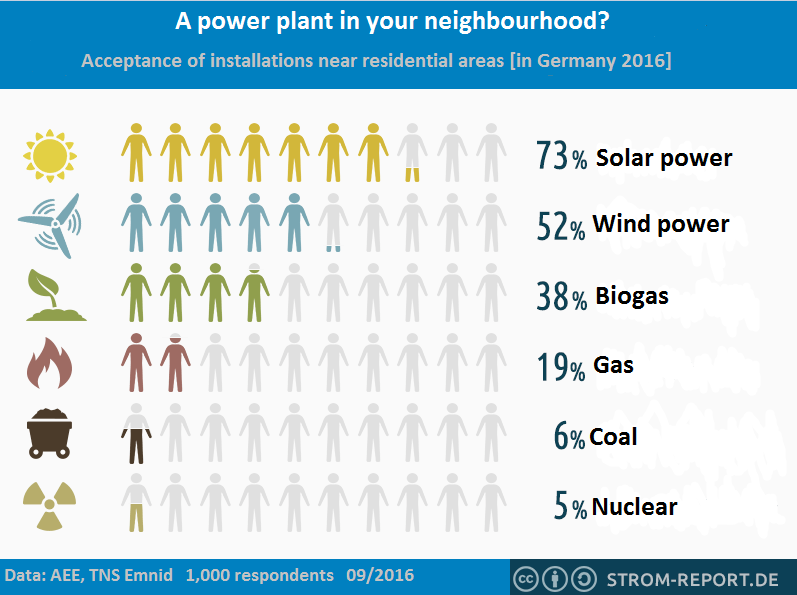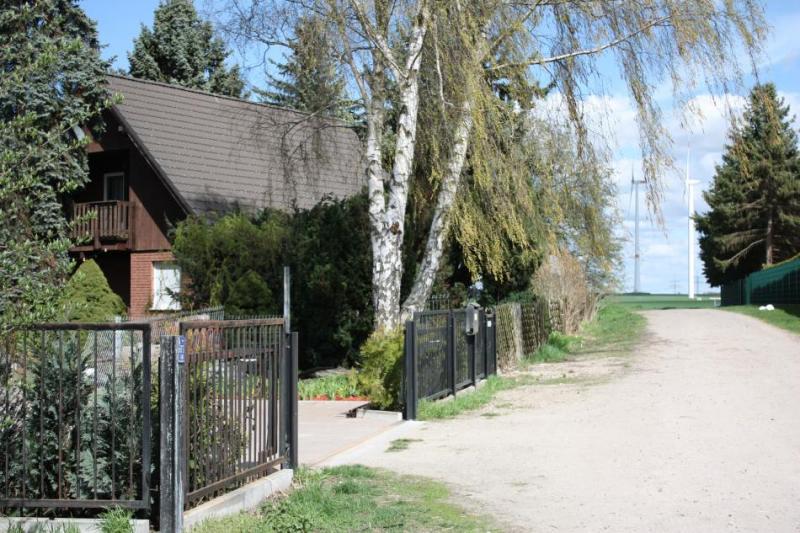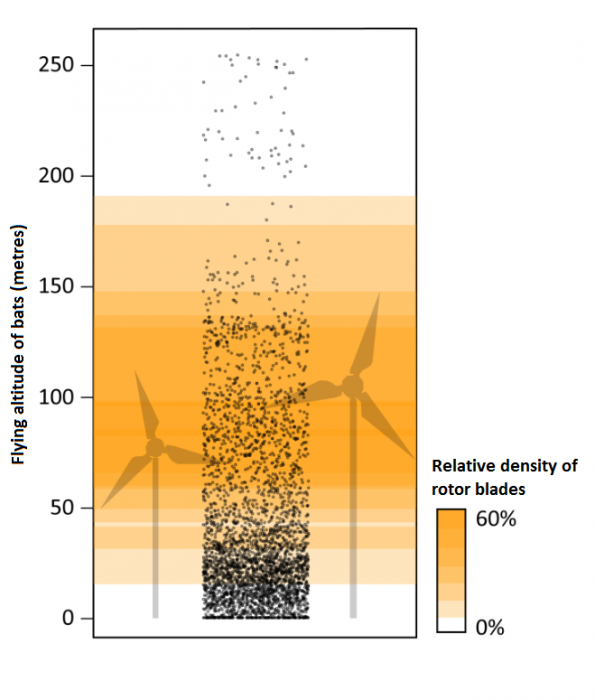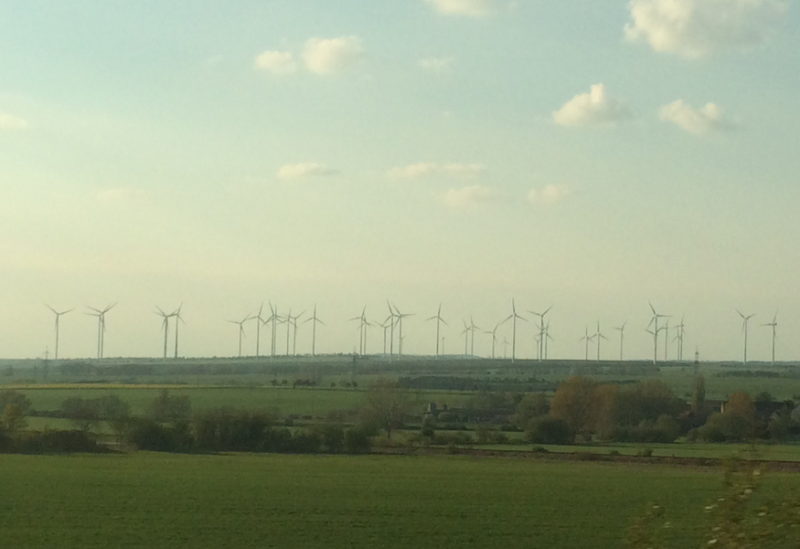Limits to growth: Resistance against wind power in Germany

Onshore wind power production in Germany is poised to become the country's leading power source of the future and has seen an enormous increase in scale in the past years. Since the year 2000, the number of turbines tripled to almost 30,000 and average height nearly doubled to 130 metres. Government expansion schemes provide for an annual capacity of about 2.5 gigawatt annually, which would roughl translate into 900 additional turbines per year. But recent expansion figures have been substantially lower than that. For the most part, this has been due to regulatory difficulties, but lawsuits against individual projects by wind power opponents and hurdles for new installations introduced by lawmakers also increasingly obstruct wind power's continued roll-out.
A survey published in October 2019 suggest that most people in Germany continue to support onshore wind power, with 82 percent of respondents saying its use as part of the country's energy transition is very important or at least quite important. But the technology's rapid spread and development also has sparked a parallel increase in protest movements across the country by people who refuse to embrace the green power installations in their neighbourhood or say they worry about the turbines' impact on local environments. “The great fear of a ‘wind industry desert,” “Wind power? Yes, but not on my doorstep,” “Protest pays off: wind power plans binned” – headlines like these have become a common sight in the country’s local and national newspapers and according to anti-wind power activist website windwahn.de (“wind delusion”), over 660 active citizen initiatives oppose wind power projects in Germany.
The industry group German Wind Energy Association (BWE) said growing resistance to new projects has become a veritable challenge for keeping wind power expansion in line with emissions reduction goals. New capacity additions dropped by over 50 percent in 2018 and plummeted even further in 2019, mainly due to projects that won renewable auctions in 2017 not having been realised as they still lack the necessary permits. But even obtaining a permit no longer creates legal certainty since most projects are contested by increasingly professional interest groups in court, the BWE says.
General acceptance of wind power installations
Despite adamant rejection of wind power by individual interest groups, the predominant sentiment among the German population towards renewables is positive; general approval rates for further expansion still reach up to 93 percent, according to a 2018 survey by the Renewable Energies Agency (AEE). [See the CLEW factsheet on citizens’ support for Energiewende for details].
Accpeptance tends to shrink, however, the closer turbine locations move to respondents' homes. According to an earlier AEE survey published by strom-report.de, 52 percent of Germans would accept wind turbines in their immediate neighbourhood – still the second best rate for any form of power production after solar power, which 73 percent of those surveyed said they would tolerate. Conventional power plants fare much worse in this respect, with coal and nuclear plants being rejected by 94 and 95 percent, respectively. However, these generally occupy less surface area than the nearly 30,000 onshore wind turbines spread over the country in 2019. 
At least adapting to wind turbines in the neighbourhood seems to be possible. Among people who already live with wind farms near their homes, acceptance climbs to over 70 percent, according to a 2014 AEE survey. Acceptance also grows for coal and nuclear plants if they have become part of people’s daily environment, but with 30 and 17 percent acceptance, respectively, conventional plants are still far less embraced than wind turbines.
Nimbys and Pimbys
Approval rates for wind power are particularly high in northern Germany, where most of the country’s turbines are located. 80 percent of those surveyed in northern states tolerate wind power installations in their vicinity, according to a survey by Renewable Energy Hamburg (EEHH). People in the North “experience the benefits of a national energy transition in their immediate surroundings, for example by economic effects in their region or circle of acquaintances,” EEHH head Jan Rispens explains.
It is fitting in this context that 84 percent prefer to source their electricity from nearby decentralised plants rather than from distant centralised units, such as coal or nuclear plants. However, a report compiled by the University of Stuttgart on energy transition perceptions suggests that this preference declines with each metre that a turbine comes closer to peoples’ homes: while a majority of 52 percent accepts a wind park within a distance of at least 5 kilometre from their homes, the number drops to 35 percent if the distance is reduced to 500 metres. Germany's government plans to introduce a minimum distance rule of 1,000 metres from residential areas that municipalities can individually deviate from. However, in 2018 the government stated that greater minimum distances in general do not substantially add to the technology's acceptance.
By contrast, the tendency towards a “not in my backyard” or "Nimby"-mentality regarding wind turbines can be abated if affected citizens are financially compensated for putting up with a wind turbine in their neighbourhood, the researchers from Stuttgart found. Almost half of respondents said they could put up with a nearby turbine if they were paid for it. Paying nearby municipalities a so-called "wind power euro," a share of the profits generated by wind farms, therefore has been proposed as a possible way to mitigate local resistance against new projects.
According to a survey conducted by the University of St. Gallen in Switzerland, about half of German citizens would consider investing in renewable power installations, with wind power a priority option. Respondents indicated “a slight preference for projects in their own neighbourhood compared to nation-wide projects.” Researchers conclude there could be an inverted trend from “Nimby” to “Pimby,” where citizens’ attitude towards renewables becomes “Please in my backyard” if they feel they get an adequate share of the installations' benefits. 
A green-green dilemma?
Despite wind power’s general acceptance, local resistance towards new and also existing installations can be all the more vigorous. The potential health risk that turbines pose to airborne animals rank among wind power opponents’ main arguments.
Increasingly, national resistance groups like vernunftkraft (“power of reason”) and specialised lawyers reach out to local residents with proposals to fight projects in their area in court, mostly with lawsuits related to species conservation, wind industry group BWE says. Court cases related to species conservation have also been used by green groups to fight major fossil fuel projects like the clearing of Hambach Forest in western Germany to make room for a coal mine.
Dangers for birds and bats caused by over 60 metre long blades rotating at over 300 kilometres per hour at their tips indeed are a controversial issue. Apart from fervent opposition groups, also several research and environmental organisations have voiced concerns over the turbines' impact on local fauna.
The Leibniz Institute for Zoo and Wildlife Research (IZW), for instance, says turbines in fact pose a threat to certain bat species, calling the “conflict between the development of renewable energy sources and the conservation” of endangered species a “green-green dilemma.” However, they say small changes to turbine operation might suffice to minimise bat fatalities.
Similarly, the Federal Agency for Nature Conservation (BfN) cites a number of precautions that should become mandatory for wind turbines built in forests to protect endangered bats, such as minimum distances from trees, turning off the rotors during certain times of the day and banning construction in designated areas. 
In the same vein, the Nature and Biodiversity Conservation Union (NABU) calls for “clear rules” to make “necessary wind power expansion” environmentally acceptable and suggests banning construction in ecologically sensitive areas altogether. The organisation estimates about 100,000 birds could be killed by rotor blades each year.
To put this figure into perspective: Environmental organisation Friends of the Earth Germany (BUND) says that about 18 million birds in Germany die every year by crashing into windows. Also NABU says that wind turbines are less dangerous for the animals than many other human interventions in the landscape. According to the NGO, more than 1.5 million birds in Germany die each year by colliding with high-voltage overhead power lines.
A study by the University of Bielefeld that systematically counted killed birds near turbines found that it was “difficult to evaluate” the actual danger of wind turbines for bird populations. But researchers said fewer endangered birds might be killed by wind turbines than previously estimated.
Cast shadows and flying icicles
Wind power critics argue turbines also threaten human health, especially due to their subsonic noise emissions. In a study by Germany’s Federal Environment Agency (UBA) from 2014, researches indeed found that subsonic noise “at a certain level” could have negative effects on the human body, such as disturbed sensory perception or circulatory problems. However, they added it was difficult to say to what extent wind power generation is responsible for emitting this particular infrasound level.
In a study on wind turbine subsonic sound’s health effects, New Zealand researchers found that participants expecting negative influences reported “significant increases (…) in the number and intensity of symptoms.” Expectations had been created “by viewing information readily available on the Internet,” they argued, suggesting that health complaints were mostly linked to psychological factors.
In a 2016 study, the UBA found that if turbines were operated correctly, “the health risk potential is very marginal.” This was true for noise emissions as much as for other threats cited by critics, such as light emissions by emergency flashers, moving shadows cast by rotors or icicles that get thrown off the blades. Technological progress largely reduced detrimental impacts of turbines, making them less dangerous for human health than CO2-emitting coal plants, the UBA concluded.
However, the UBA acknowledged that residents living near turbines often had fears and reservations “in spite of clear scientific indications” that could best be mitigated by closely involving the public in the planning stages of new projects.
More than half of respondents in Stuttgart University’s survey said wind park planning insufficiently provides for public participation; more than a third added greater involvement could help to increase acceptance. A similar share stated that installations owned by citizen cooperatives would be welcomed more than wind turbines operated by large investors.
“Asparagus” spoil the country
Apart from concrete health risks, opponents of wind power also state that they are repulsed by the aesthetic impact of the giant “asparagus” on Germany’s landscape, as these would spoil “the character of our country.” Martin Prominski, professor for landscape management at the University of Hannover, explained this rejection to Süddeutsche Zeitung with the German fondness for romanticism, saying that “our ideal is preindustrial landscape impressions” that does not conform to modern technology.
But resistance to new installations can also have less emotional causes: Protest groups in coastal state Mecklenburg-Vorpommern voiced concerns that wind turbines built off the coast might put off tourists and thus negatively affect local incomes, Hamburger Abendblatt reported. Likewise, concerns over impairment of land property values by real-estate owners are a prevalent factor in wind power criticism. 
According a regional branch of German land owner association Haus&Grund, these fears are “absolutely founded." Property values could “drop by 20 to 30 percent or homes could even become unsellable in extreme cases” if wind turbines are erected nearby, local chairman Axel Tausendpfund told Rhein-Neckar-Zeitung. The real estate lobbyist therefore calls for compensation schemes for land owners, a concept offered by Danish law since 2009.
However, while some studies could not find a negative correlation between property prices and wind turbine proximityat all, others document a much smaller impact on property prices than those suggested by the land owner lobby group. Research institute RWI found that the value of a one-family house falls by an average of 7 percent once a wind turbine is built within a 1-kilometre radius around the property due to potential noise pollution and the turbines’ aesthetic impact. The effect disappears at a distance of 8 to 9 kilometres. The study found that the value loss was greatest for older houses in rural areas, where prices dropped by up to 23 percent. On the other hand, almost no devaluation was observed for houses built on the outskirts of larger towns.
The German Wind Energy Association (BWE) estimates that about two percent of Germany’s surface would be sufficient to cover wind power’s planned share in the country’s power mix. The lobby group says increased turbine productivity could help minimise wind power’s land requirement, but that a rising demand for renewable power probably will not let the needed area shrink.
In a 2018 study, the institute for Applied Ecology (Öko-Institut) found that conflicts over areas for renewable power production were set to become a decisive factor for the future course of Germany's energy transition, calling land "the new currency" of the Energiewende. The study said Gemany would on average need 2.5 percent of the land area available in each administrative district to comply with its 2050 renewables expansion scenario. This area could be reduced to only 2 percent if a greater focus was put on solar power expansion rather than building more onshore wind turbines.
Wind power opposition has fully entered party politics
The rising visibility of protests against new turbines has also prompted many political parties at the regional level to take a stance for or against certain projects.
In southern state Bavaria, the so-called 10H-rule introduced by conservative party CSU and backed by a constitutional court ruling in 2016 regulates that new installations need to maintain a distance equal to ten times the turbine’s height. Following a lawsuit by opposition parties, the court agued that the rule "significantly restricted but not eliminated" wind power expansion, a finding that was contested by wind power proponents. However, the new coalition with Bavaria's Free Voters, who support greater renewables expansion, could force the CSU to amend its decision.
Other states have since followed suit in tightening wind power epxansion rules, including Germany's largest federal state North Rhine-Westphalia and coastal Schleswig-Holstein, a wind power hotspot often dubbed as "the cradle of the Energiewende." However, according to Germany's federal government, most states have no interest in actually implementing tighter regulation. The government says there is no indication that a minimum distance leads to greater acceptance of wind power among citizens, and says the visibility of turbines and involvement of citizens in the planning stages play a much greater role.
Germany's environment agency UBA warned against sweeping minimum distance rules as these would threaten the success of Germany's entire energy transition. A limit of 1,000 metres, for example, would reduce the land available for turbines by 20 to 50 percent, the UBA said, adding that this would mean that “sufficient expansion of wind power” to meet Germnay's climate targets “would be almost impossible”. It argues that requirements for every wind power project should be decided on a case-by-case basis.
A government-appointed commission set up in late 2018 has been tasked with debating possible measures to increase the acceptance of wind farms in the country. These include design and planning questions to minimise the turbines' visual impact and financial options to guarantee municipalities and, by extension, citizens receive a greater share of the profits made with wind power. Results are expected by April 2019.

